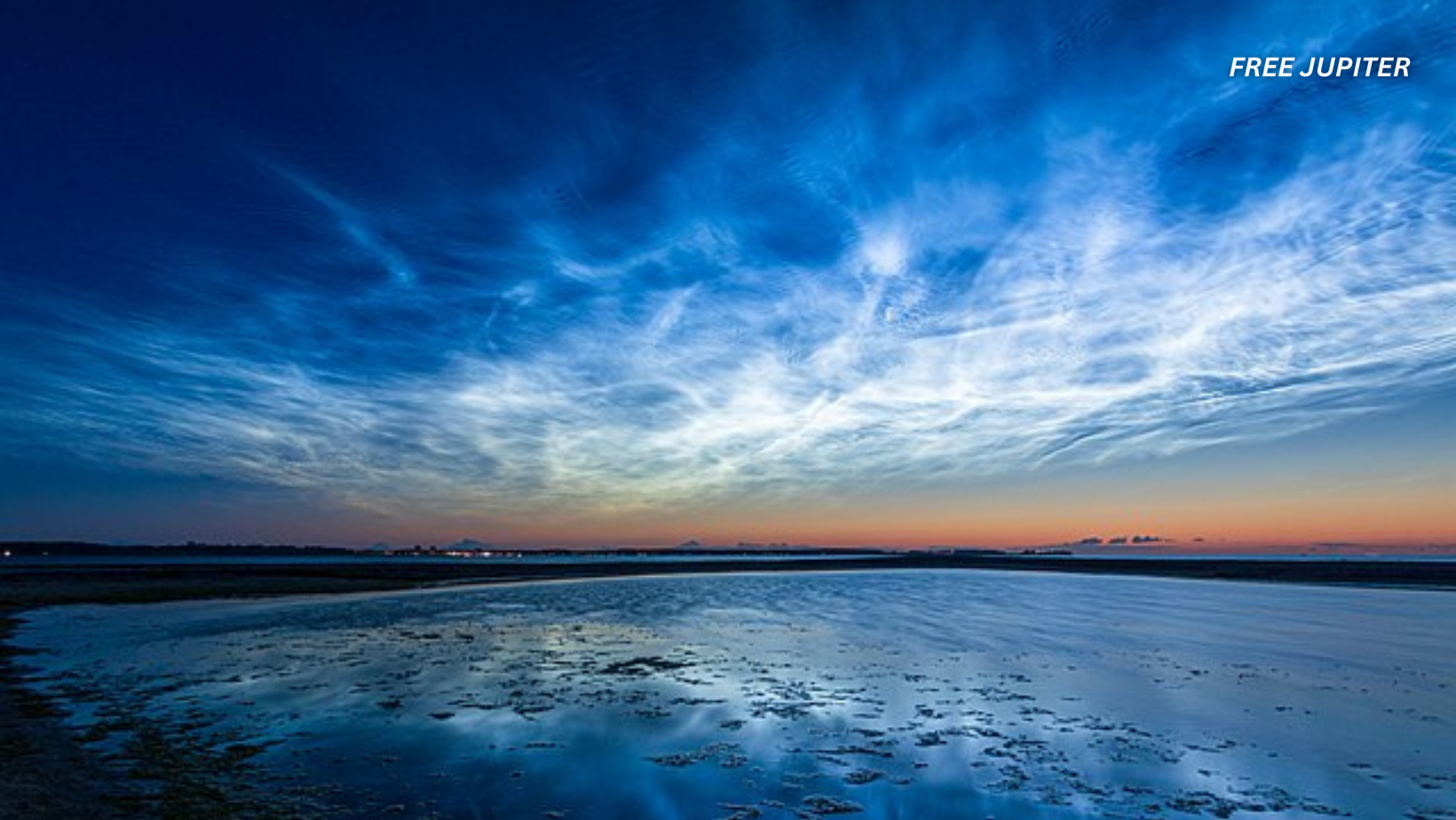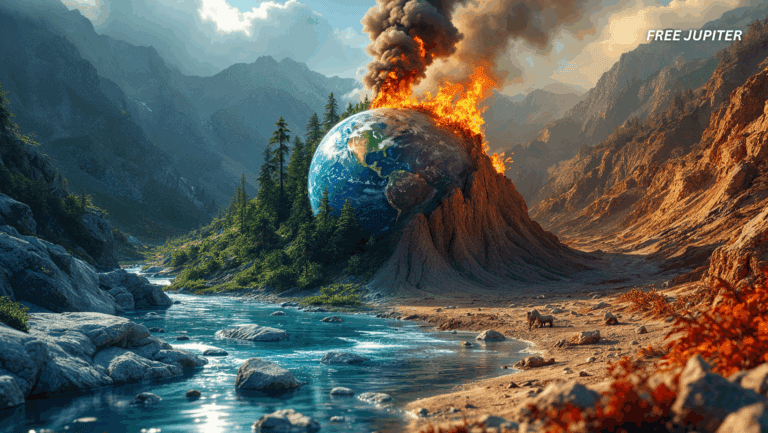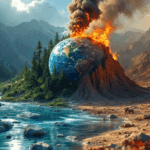Friendly Note: FreeJupiter.com shares general info for curious minds 🌟 Please fact-check all claims—and always check health matters with a professional 💙
Just as summer begins to stretch its golden fingers across the Northern Hemisphere, a ghostly glow takes to the skies — an ethereal phenomenon making its annual return. Known to scientists as noctilucent clouds and romantically dubbed “night-shining clouds” by skywatchers, these rare atmospheric wonders are once again gracing twilight skies, appearing like shimmering, electric-blue veils high above the Earth.
Only visible for a handful of weeks each year, these clouds are more than just a visual treat — they’re atmospheric enigmas that spark curiosity among scientists and stargazers alike. Hovering in the upper reaches of the atmosphere, where the air is thin and temperatures plunge, these delicate ice-clouds drift silently, catching sunlight long after the sun has disappeared from view.
A Fleeting Invitation: When and Where to Look
If you’re hoping to catch a glimpse of these elusive beauties, timing and location are everything. The viewing window is surprisingly narrow, limited to a few short months between late May and mid-August. Within this brief seasonal slot, June and July typically offer the most frequent and vivid displays.
The magic moment usually unfolds 90 to 120 minutes after the sun sets, or just before it makes its morning return — that hazy period where the sky isn’t fully dark nor fully lit. These luminous clouds prefer higher latitudes, appearing between 45 and 80 degrees north. That means your best bet lies in places like North Dakota, Montana, and Washington in the United States, or further afield in parts of Northern and Eastern Europe such as Norway, the UK, and Lithuania.
But don’t expect to see them alongside your standard weather clouds — these celestial wisps reside in a far loftier domain.
Read more: Noah’s Ark Found On a 3,000-Year-Old Babylonian Map
Soaring Beyond the Weather: A Home in the Mesosphere
What sets noctilucent clouds apart from the typical puffy formations floating lazily across your afternoon sky is their altitude. Instead of lounging a few miles above the surface like ordinary clouds, noctilucent clouds cruise nearly 50 miles (around 80 kilometers) up in the mesosphere. That’s more than six times higher than most weather systems operate — a zone so remote and frigid that it borders on the edge of space.
Temperatures in this realm can drop to a bone-chilling –130°F (–90°C), making it a perfect environment for the formation of high-altitude ice crystals. But here’s the twist: water vapor is incredibly scarce at that height. So how do these clouds even form?
Dust, Ice, and the Ingredients of a Sky Spectacle
The process begins with warm air from the surface rising into the upper atmosphere, especially during summer when circulation patterns push moist air upward. As it climbs, the air expands and cools rapidly, eventually hitting the right temperature for ice crystals to take shape.
But these crystals need something to cling to — and that’s where the space dust comes in.
Tiny specks of cosmic debris, often from micrometeors burning up in Earth’s atmosphere, act as the scaffolding around which the ice crystals form. Other particles may originate closer to home: volcanic eruptions, pollution, and even rocket launches contribute dust and moisture to this icy cocktail. Recent studies even suggest that launches by satellites and space-bound vehicles could be enhancing noctilucent cloud formation.
As these crystals gather and reflect sunlight from beyond the horizon, they create the ghostly blue and white patterns that have captivated observers for decades.
Read more: Scientists Have Just Discovered A Brand New Continent
A Growing Mystery: Expanding Reach and Changing Climate
One of the more intriguing developments surrounding noctilucent clouds is their changing behavior. Historically confined to extreme northern latitudes, these clouds are now being observed farther south than ever before. This shift has raised eyebrows in the scientific community, prompting questions about its possible links to broader environmental changes.
Some experts suspect that climate change — particularly the increasing presence of greenhouse gases — may be altering the upper atmosphere in ways that favor noctilucent cloud formation. Others point to the expanding number of rocket launches as another contributing factor, introducing more water vapor and dust particles into high-altitude regions.
While the precise cause remains an open question, it’s clear that the skies are changing, and these clouds are offering subtle hints about shifts in Earth’s atmospheric dynamics.
A Light Show Like No Other
Visually,are unlike anything else in the sky. Their glow isn’t self-generated like the aurora, nor do they borrow their drama from stormy weather. Instead, they rely on the perfect orchestration of timing, altitude, and sunlight. Their high albedo — a scientific term meaning their ability to reflect light — allows them to shine even as the world below slips into darkness.
Their distinct spectral-blue hue makes them unmistakable. Photographers from Vilnius to Sunderland have managed to capture stunning vistas of these shimmering trails weaving through twilight skies, arching over rivers, rooftops, and rolling fields like luminous brushstrokes across a canvas.
And unlike most clouds that block your view of the cosmos, noctilucent clouds enhance it. They drift silently and elegantly across star-filled skies, adding texture and brilliance rather than obscuring the heavens.
Tips for Skywatchers: How to Spot Them
To catch a noctilucent cloud in action, you’ll need a bit of luck and a lot of patience. First, head to an area with minimal light pollution — preferably with a wide, unobstructed view of the northern horizon. Then, monitor the sky for about 1 to 2 hours after the sun has set, or just before it rises. You’re looking for glimmers of silver, white, or electric blue weaving high above the landscape.
Clear skies are essential, and weather conditions can change your chances dramatically. Having a camera ready with long exposure settings can also help capture their fine structure — they’re far more delicate than average clouds and may fade within minutes.
Additionally, astronomy apps and websites often provide alerts or forecasts for noctilucent cloud visibility. Following social media accounts of amateur astronomers or weather watchers in your region can also be a helpful way to get real-time updates.
Read more:If You Survive Until 2050, Experts Say You May Be Able To Dodge Death Entirely
A Reminder of Earth’s Atmospheric Ballet
What makes noctilucent clouds so remarkable isn’t just their beauty — it’s the reminder that even in the uppermost fringes of our planet’s atmosphere, there are systems at work that we’re only beginning to understand. These clouds act as both scientific indicators and aesthetic marvels, hinting at the subtle interactions between Earth’s climate, space weather, and human activity.
Whether you’re a casual skywatcher or a seasoned astrophotographer, catching a glimpse of these twilight apparitions can feel like stumbling upon a secret performance — one that plays out quietly above, often unnoticed by the world below.
So the next time you find yourself under a clear summer sky, cast your gaze upward in those late-evening or early-morning hours. You just might witness one of the atmosphere’s most ghostly and graceful expressions: the return of the night-shining clouds.










